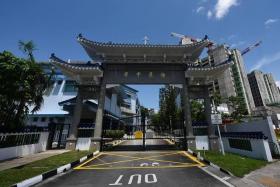Bullying not acceptable and has no place in schools: Ministry of Education
Bullying is not acceptable and has no place in schools, the Ministry of Education (MOE) said on Friday (Aug 19), after a video emerged showing three girls beating up another girl in a Sengkang carpark.
When there are reports of alleged cases of bullying, school staff seek to understand the underlying causes, as incidents of bullying can be complex, said an MOE spokesman.
"(These cases) extend into the online space, and often involve unresolved relationship issues," the spokesman added, in response to queries from The Straits Times.
"Counselling support is provided to the students involved, and appropriate disciplinary actions are meted out where necessary to help students understand that there are consequences for anti-social and hurtful behaviour."
MOE's response comes after the three girls, all aged 15, were arrested for wrongful confinement. They are under investigation for voluntarily causing hurt.
The trio are alleged to have assaulted another teenage girl at a multi-storey carpark at Block 269 Compassvale Link.
In videos circulating online on Tuesday, the victim is seen cowering on the floor as her assailants punch, kick and slap her.
Two teenage boys, who are believed to be wearing T-shirts from Jurong Secondary School, can be seen looking on.
Jurong Secondary did not immediately respond to queries.
There were two incidents of bullying involving students - a case of hazing at Ngee Ann Polytechnic and an ITE College Central student slapping his schoolmate - in March 2021.
On Friday, MOE said that since 2012, the number of such incidents reported each year to schools has remained low, at about two incidents per 1,000 primary school pupils and five incidents per 1,000 secondary school students.
There were more than 232,000 pupils enrolled in primary schools and 162,000 students in secondary school last year, according to MOE statistics.
When asked what policies have been put in place to address bullying, the MOE spokesman said that schools instruct students about the subject and also implement preventive measures. There are also intervention measures in place.
Said the spokesman: "All students are taught the safe channels to report serious incidents, inappropriate practices, or hurtful behaviours. Peer support leaders also help to keep online and offline spaces safe and positive, and alert teachers where needed... Schools also engage parents and work with them to provide students with the necessary support both in and out of school."
As part of efforts to establish a caring and enabling learning environment, schools appoint dedicated staff to oversee and build a peer support culture in the learning, social and cyberspace, the spokesman added.
Counsellors ST spoke to said that while they have not seen a rapid increase in the number of bullying cases in recent years, videos such as the one reported on Tuesday may be the tip of the iceberg.
Ms Lauren Yeo, principal counsellor of Restart Counselling for Wellness, said that besides incidents involving physical violence, bullying can also include subtler forms such as belittling a victim, body shaming and ostracisation.
Ms Yeo added: "For youth, the main reasons why they may bully others boils down to jealousy and competition. This could take place in the context of romantic relationships, changes in friendship group dynamics or social media comparisons.
"Bullies act the way they do for various reasons, such as a need for attention, to feel in control, especially when they feel vulnerable or because they do not know how else to resolve negative emotions in a more effective way."
Dr Annabelle Chow, a clinical psychologist who runs the practice Annabelle Kids, said that while the stereotype exists that youth who are bullied are weaker, for example, because they have learning difficulties or an unusual physical appearance, anyone can become a victim.
Noting that the feelings of pain and helplessness can last long after an incident, Dr Chow said it is important victims know that they are not at fault and that these experiences do not define them.
She said: "Bullying is never acceptable. When you have been mistreated, know that these actions are a reflection of who the other person is and not your worth."
Get The New Paper on your phone with the free TNP app. Download from the Apple App Store or Google Play Store now



